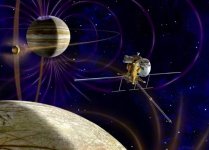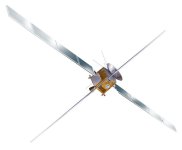Europe or Titan? The node will soon by minced
Wednesday, February 18, 2009
Two scientific teams have filed their final proposal for either a mission to Jupiter, Europa and Ganymede or a mission to Saturn, Titan and Enceladus. 9 and 10 March ESA and NASA should take a decision. What is the next big mission to the planets? On the one hand there is the Europa Jupiter System Mission with a research satellite to Europe and one for Jupiter and Ganymede. On the other hand there is the TSSM program with a Titan orbiter, a lander and a balloon for a wet landing.
It is almost impossible to choose: on the one hand, Jupiter with its Monday Europa, a moon covered with ice, and it is not unlikely that there is an ocean under the ice is. And when Ganymede would like to make a living. On the other hand, we have Saturn. In the ongoing Cassini mission, we are a lot wiser on Saturn with its rings. But there are also new questions: Titan remains mysterious. It seems that the surface floats on an ocean of water. And organic molecules on Titan would be something we can say about the beginning of life on our planet. Enceladus has then spitting geyser of water.
Both the planets and their moons are incredibly interesting. However, there is only money for one of these programs. Both programs cost of billions. In both missions cost about as much.
Jupiter Europa Orbiter Mission
The Jupiter Europa Orbiter Mission consists of a Jupiter Europa Orbiter (JEO) of NASA and a Jupiter Ganymede Orbiter (JGO), to Europe. The JEO the deep interior of Europe mapping, search for any surface and try to obtain a picture of the history of Europe. Also, from a job for Europe's chemical mapping and try to answer the question: could life be? The great challenge of JEO is that it often goes in the radiation belt of Jupiter. Simple home-garden and kitchen electronics would be in the radiation field of Jupiter quickly damage. An additional challenge is to build a satellite that is hardened against radiation jovi Italian.
The JGO is a satellite outside the radiation belt in orbit around Jupiter will rotate. This satellite will from a distance, the interaction between Jupiter and moons observe. JGO after research in orbit around Ganymede go. This will be the structure in this investigation Monday. Unlike JEO, the supply of solar panels JGO
JEO and JGO Both should be launched in 2020. JEO on an Atlas V, JGO on an Ariane V. After a so-called veega pathway (Venus-Earth-Earth Gravity Assist) are in 2025 and 2026 at Jupiter on. First few years they will rotate around Jupiter. Then come JEO and JGO in orbit of "their" Monday Eventually they will also come down. That is remarkable, because the Jupiter Galileo mission was NASA satellite that just come down to Jupiter for a crash in Europe and, possibly Europe organic contamination could affect.
The Jupiter Europa Orbiter from a brochure of NASA.
Wednesday, February 18, 2009
Two scientific teams have filed their final proposal for either a mission to Jupiter, Europa and Ganymede or a mission to Saturn, Titan and Enceladus. 9 and 10 March ESA and NASA should take a decision. What is the next big mission to the planets? On the one hand there is the Europa Jupiter System Mission with a research satellite to Europe and one for Jupiter and Ganymede. On the other hand there is the TSSM program with a Titan orbiter, a lander and a balloon for a wet landing.
It is almost impossible to choose: on the one hand, Jupiter with its Monday Europa, a moon covered with ice, and it is not unlikely that there is an ocean under the ice is. And when Ganymede would like to make a living. On the other hand, we have Saturn. In the ongoing Cassini mission, we are a lot wiser on Saturn with its rings. But there are also new questions: Titan remains mysterious. It seems that the surface floats on an ocean of water. And organic molecules on Titan would be something we can say about the beginning of life on our planet. Enceladus has then spitting geyser of water.
Both the planets and their moons are incredibly interesting. However, there is only money for one of these programs. Both programs cost of billions. In both missions cost about as much.
Jupiter Europa Orbiter Mission
The Jupiter Europa Orbiter Mission consists of a Jupiter Europa Orbiter (JEO) of NASA and a Jupiter Ganymede Orbiter (JGO), to Europe. The JEO the deep interior of Europe mapping, search for any surface and try to obtain a picture of the history of Europe. Also, from a job for Europe's chemical mapping and try to answer the question: could life be? The great challenge of JEO is that it often goes in the radiation belt of Jupiter. Simple home-garden and kitchen electronics would be in the radiation field of Jupiter quickly damage. An additional challenge is to build a satellite that is hardened against radiation jovi Italian.
The JGO is a satellite outside the radiation belt in orbit around Jupiter will rotate. This satellite will from a distance, the interaction between Jupiter and moons observe. JGO after research in orbit around Ganymede go. This will be the structure in this investigation Monday. Unlike JEO, the supply of solar panels JGO
JEO and JGO Both should be launched in 2020. JEO on an Atlas V, JGO on an Ariane V. After a so-called veega pathway (Venus-Earth-Earth Gravity Assist) are in 2025 and 2026 at Jupiter on. First few years they will rotate around Jupiter. Then come JEO and JGO in orbit of "their" Monday Eventually they will also come down. That is remarkable, because the Jupiter Galileo mission was NASA satellite that just come down to Jupiter for a crash in Europe and, possibly Europe organic contamination could affect.
The Jupiter Europa Orbiter from a brochure of NASA.





